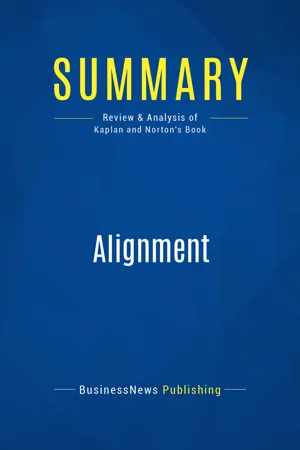
Summary: Alignment
Review and Analysis of Kaplan and Norton's Book
- English
- ePUB (mobile friendly)
- Available on iOS & Android
About this book
The must-read summary of Robert S. Kaplan and David P. Norton's book: `Alignment: Using the Balanced Scorecard to Create Corporate Synergies`.
This complete summary of the ideas from Robert S. Kaplan and David P. Norton's book `Alignment` shows that most organisations consist of multiple departments and operating units which are run by highly trained individuals. Whilst each unit operates consistently and efficiently, the collaboration between units is not always aligned. Kaplan and Norton’s scorecard system allows you to create an “enterprise-level strategy map”, which will help you maximise the potential value in your business by aligning all internal operations and services. The result is not only more profitable, but also very cost effective as there is less misalignment, duplication and waste.
Added-value of this summary:
• Save time
• Understand key concepts
• Expand your knowledge
To learn more, read `Alignment` and discover the benefits that using a Balanced Scorecard can bring for your company.
Frequently asked questions
- Essential is ideal for learners and professionals who enjoy exploring a wide range of subjects. Access the Essential Library with 800,000+ trusted titles and best-sellers across business, personal growth, and the humanities. Includes unlimited reading time and Standard Read Aloud voice.
- Complete: Perfect for advanced learners and researchers needing full, unrestricted access. Unlock 1.4M+ books across hundreds of subjects, including academic and specialized titles. The Complete Plan also includes advanced features like Premium Read Aloud and Research Assistant.
Please note we cannot support devices running on iOS 13 and Android 7 or earlier. Learn more about using the app.
Information
Summary of Alignment (Robert S. Kaplan and David P. Norton)
Foundation: Strategy Maps and Balanced Scorecards
- Financial – What are our shareholder expectations for financial performance?
- Customer – To reach those financial objectives, how do we actually create value for our customers?
- Internal – Which processes must we excel at in order to create satisfied customers and shareholders?
- Learning and Growth – How can we align our intangible assets – such as our people, our systems and our culture – in such a way that doing this will improve the critical processes?
- Action Plans – which detail the different initiatives taken in each part of the business, along with their respective budgetary allocations.
- Strategic Plans – which can be used to guide management decision making about areas of future investment.
- Other frameworks and metrics which measure and reflect the organization’s ongoing progress.

Table of contents
- Title page
- Book Presentation
- Summary of Alignment (Robert S. Kaplan and David P. Norton)
- About the Summary Publisher
- Copyright